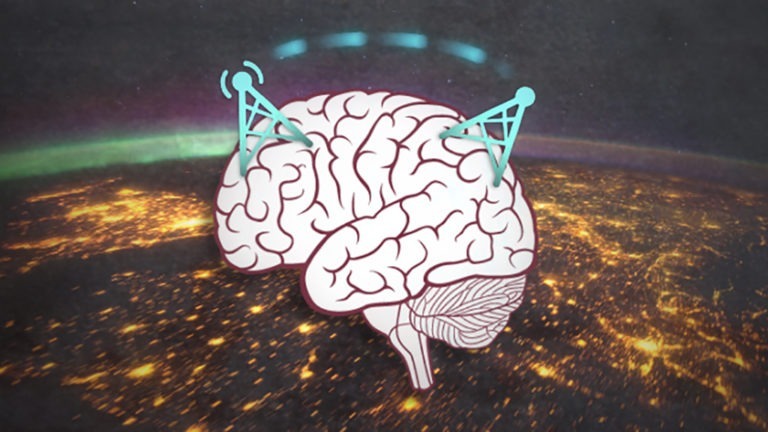Tiny Crystals In Our Brain Could Unlock Psychic Powers

Magnetite is one of the most magnetic substances on Earth. As you can probably guess, it has a diverse range of uses; from fridge magnets to generating electricity in power plants. But what you probably wouldn’t guess is that your brain actually synthesizes these crystals, and you have hundreds of millions of them inside your head. Much smaller ones of course.
Scientists are still unsure what role, if any, these crystals play in the brain’s function. Studies have inferred that it may play a role in long-term memory. In animals, like honey bees, homing pigeons, and dolphins, magnetite is believed to be associated with the ability to respond to the Earth’s magnetic field.
While similar studies have yet to be performed on humans, we do know that Earth’s magnetic fields effect everything from our mood to our ability to learn. Even stranger, research has begun to provide links between the electromagnetic field of our planet and psychic abilities. Could these crystals act like tiny antennas connecting our brains to each other and to the entire planet? It may sound far-fetched, but surprisingly, the evidence is there.
First, let’s look at what we know about the magnetite in our brains. To be honest, we don’t know much: In 1992, the first evidence of this mineral in the brain was published. It was shocking to uncover that this highly magnetic substance was actually synthesized by our bodies, and while we don’t know exactly what function it plays in brain activity, some interesting theories have emerged. A 2009 hypothesis proposed that magnetite plays a significant role in long-term memory. It suggests that cellular components of the brain communicate with each other through magnetic signals, with the magnetite particles acting as tiny antennas, simultaneously receiving information throughout the different parts of the brain.
Magnetite also acts as an antenna for external electromagnetic fields, including the geomagnetic field of the Earth itself. And this is where things start to get interesting. An enormous body of research is emerging that shows substantive links between magnetic fields and cognitive function.
Back in 1978, research physicist Dr. Robert C Beck published preliminary research on the effects of extremely low frequency magnetic fields on the moods of human subjects. ELF fields of 6.67 Hz, 6.26 Hz and lower tend to produce symptoms of confusion, anxiety, depression, tension, fear, mild nausea and headaches. On the other hand, oscillations of 7.8, 8.0, and 9.0 Hz produce anxiety-relieving and stress-reducing effects that mimic some meditative states.
More recently, magnetic fields have been used in successful clinical practices for eliminating depression and bipolar disorder, with over 1300 medical research papers published to date. The non-invasive treatment, known as repetitive transcranial magnetic stimulation, uses a wand-shaped gadget to zap away the effects of depression.
While all of this is interesting, and can pave the way for new therapies and treatments, a group of researchers at Canada’s Laurentian University are exploring the role of electromagnetic forces in more extreme cognitive functions. Dr. Michael Persinger is a neuroscientist who has argued that all phenomena, including consciousness, spiritual experiences, and even “paranormal events,” can be explained by physical mechanisms, and can be verified using the scientific method.
Since 1971, he has been researching electromagnetic field effects upon biological organisms, and some of his recent studies sound straight out of a sci-fi movie: Dr. Persinger has shown in the laboratory that magnetic brain stimulation can create metal states conducive to human telepathy. A recent experiment placed two people at a distance in different rooms, each surrounded by an identical, computer-controlled magnetic field. When a light was flashed in one subject’s eye, the person in the other room showed responses in their brain as if they saw the flash of light.
As Dr. Persinger stated:
“We think that’s tremendous because it may be the first macro demonstration of a quantum connection, or so-called quantum entanglement. If true, then there’s another way of potential communication that may have physical applications, for example, in space travel.”
On a much larger scale, correlation has been shown between the geomagnetic forces of the planet and a variety of effects spanning large populations. A 2003 study found “strong empirical support in favor of a geomagnetic-storm effect in stock returns” and “evidence of substantially higher returns around the world during periods of quiet geomagnetic activity.”
Other research has linked geomagnetic activity to suicide, heart-disease, and even birth rates. A particularly curious global effect is related to a standing electromagnetic wave that exists between the Earth’s surface and the ionosphere. Known as “The Schumann Resonance,” this wave has a frequency of 7.8 Hz, and is frequently referenced in alternative theories of consciousness. Measurements by Dr. Persinger have shown that the fundamental and harmonics of the Schumann Resonance were discernible in normal human brain activity, and in fact they correspond to Dr. Beck’s anxiety-reducing ELF fields.
Stranger still was Persinger’s study of the remote viewer Ingo Swann. “Remote viewing” refers to a technique used by “psychic spies” working for the CIA; they were able to see far off locations as if they were there; and they could even move through time. Ingo Swann was one of the first, and most accurate, viewers in this program. When Dr. Persinger measured his brain’s electromagnetic activity during viewing sessions, he found a spike in activity at 7 Hz which correlated with the most accurate viewings. Is it possible that Swann was able to project his consciousness by tuning into the standing geomagnetic waves of the Earth?
All of this adds up to a fascinating connection between our brains and the shared magnetic field not only of our planet, but potentially of the entire universe. It’s undeniable that the brain responds to magnetic forces on a local and a global scale. While no one has been able to prove the involvement of magnetite, it seems a likely suspect. If we learn to harness the power of these tiny antennas in our brain, who knows what kind of psychic superpowers we might unlock?
Did You Psychically Inherit Society's Learned Behavior?

The scientific community is often very rigid in its process and not always open to radical ideas. Rightfully so, that is the nature of science – strict scrutiny and skepticism. But what if it is limiting itself in this approach, in the sense that it has taken on some of the same parochial propensities of religion? Science is supposedly the antithesis of religion and meant to question everything with the goal of new discovery. While it is necessary to maintain skepticism to prevent charlatans from diluting the scientific process, there should be a certain level of tolerance for new ideas.
Rupert Sheldrake is one of those scientists that his community has largely shunned as a heretic. Despite studying at Harvard and graduating from Cambridge with a Ph.D. in biochemistry, the scientific community has dismissed his radical ideas as nonsensical and blasphemous. Sheldrake admittedly started his career in science as an atheist, but eventually had an epiphany about our consciousness that changed his outlook.
Sheldrake has proposed an idea he calls, morphic resonance. Essentially, the idea is that there is a collective consciousness within species that can impact disparate groups of organisms without them having to come into contact with each other. A sort of telepathic connectedness that can influence behavior and can be passed down through immediate generations.
Lamarckian Inheritance
The idea of learned behavior being inherited, or Lamarckian Inheritance, has been shown to be a pretty promising theory, if not proven. Although unsurprisingly, the scientific community doesn’t all agree on this. Regardless, this idea is fundamental in Sheldrake’s theory.
The evidence comes from a study in the 1920s, where rats were tested by being placed in a water maze they had to escape from. The rats were electrically shocked when they chose one of two exits deemed to be the wrong exit. They eventually learned which exit was the correct one over a trial of several hundred tests. As they got better, their offspring were tested, and immediately showed quicker rates of improvement compared to their parents.
This was evidence of Lamarckian Inheritance, the learned behavior of the parent rat was passed on to their progeny. What was more astonishing, according to Sheldrake, was that when these experiments were conducted in labs in other countries and on the other side of the world, rats that had no contact with the original study, essentially picked up where the improved rats left off.




































